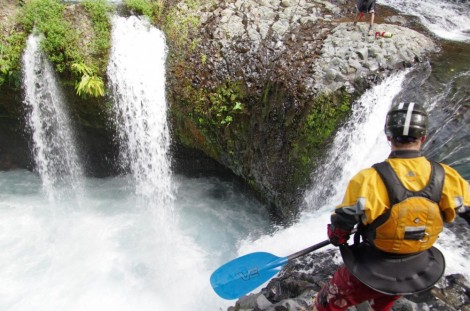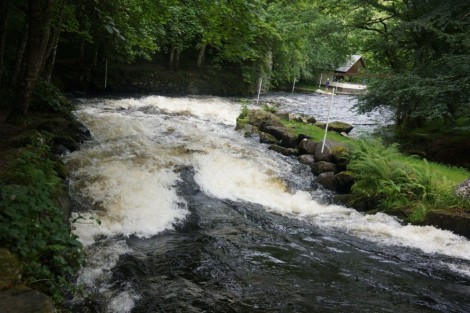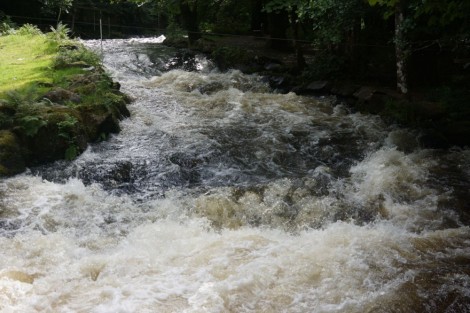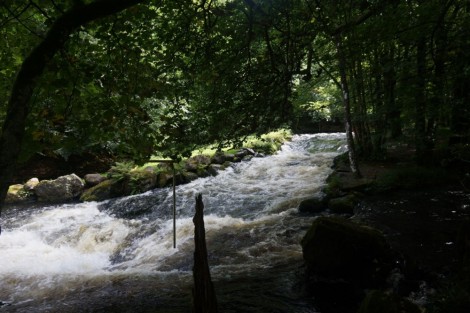Head games: Leading from the inside
Pushing your self to paddle harder rivers and rapids is not always easy. Before you make that decision to put on, there are so many different pressures and questions; Will I make all the necessary moves? Am I ready for this? Where will that water push me? Why do I even want to paddle this? Is that stopper flushing enough? Will I get hurt? What if I go over?
Most of the time when I’m confronted with a harder rapid, these kind of questions start to race through my head. To be honest I would be worried if they didn’t. After all, fear is mainly formed by the unknown or negative past experiences. To paddle a rapid well I find my mind needs to be 100% clear, focused and committed. But with all those questions whizzing around, it can be hard to achieve.
Somewhere between scouting that rapid, and dropping in I usually manage to settle the nerves and get myself into that clear state of mind. Over the past few years, I have developed a technique that helps me to do this. So I thought I would share & discuss it, in the hope that it may be useful to others. It’s very possible its something you already do, if this is the case perhaps this article will draw some attention to the skill, and help you develop it.
To get us started the skill I’m going to be talking about is commonly known as visualization; put in simple terms, imagining. Think back to a rapid that you have paddled multiple times. I’m guessing the more times you paddle it, the better you get at it (excluding the odd unlucky mess up) There are many reason we usually paddle stuff better after a few attempts but in essence the main reasons are because we start to get a feeling for what the water is going to do to us and when we need to place our strokes to get us down in good style. Provided you can agree with the above sentence, you will hopefully kind of agree with the next one. If we can get good enough at visualizing our selves paddling a rapid, then we have effectively paddled it, and have therefore already practiced it. So when we ‘actually’ paddle said rapid, we should be better off than if we had not visualized it.
An exercise for you; Imagine you are at the top of one of the more challenging rapids you have ever undertaken. You have scouted the rapid, safety is all set up and your boat is waiting at the top, now it’s all up to you. Can you imagine yourself paddling the line? If so, how vividly? Is your image in colour? Are you imagining your self in first person or third person? Can you make out every single move? Are you styling the line or do you see yourself messing up? Can you hear the water? Is it in real time, slow motion or fast forward? Can you sense what it feels like?
If you can answer some of these questions then you already possess the skill’s to visualize. Which I’m fairly sure everyone can do to some extent or another? However like all skills, they can be improved with good practice.
Unwrapping the skill of visualizing our selves paddle a rapid also expose’s other skills which we need to master. One of which is reading the terrain (white water/rapids). If we cant read the terrain, then we are not going to be able to work out where we need to go and if we cant do that, then we cant visualize our route through the rapid. If your new to white water, try to ask better paddlers about rapids, find out about the different features and how the river works. Reading the river is a skill and I think we can always improve it throughout our kayaking careers.
Once you are able to read the terrain and pick a path, you need to have a good idea of how you are going to get your boat to follow that route. Here is where we need to understand both the tactics (e.g lateral momentum etc) and the hard skills (e.g paddle waggling, edging etc) of white water kayaking.
With these two major components in place we are free to see the best route though a rapid, and know how to command the boat to follow that path. From that point on successful visualization becomes a lot easier. The reason it becomes successful visualization is because we are now creating an image of what should in theory be a positive out come e.g we style the rapid because we have picked a good line and rehearsed the correct moves.
I think it’s important to point out that picking a line, is not the same as actually imagining your self paddle it.
Going back to that first exercise, you can hopefully see that there is a sliding scale of creating an imaginary event. At the simplest end we might just be able to see ourselves from a third person point of view, but the images is hazzy and we cant work out how every move might look. And at the other end, we can create an image so intense it feels real.
My theory is that the more realistic an image (or perhaps brain video?) We can create, the more useful it’s going to be to us.
Second Exercise: Look at the photos bellow of the same rapid. Your challenge is to pick a line, and then to see if you can visualize yourself paddle it. Can you create these pictures into a brain video of yourself paddling the rapid?
If you can, it’s probably because you have paddled a similar rapid before. If you have never paddled anything like this, then it may be very difficult to picture. The reason behind this is because of Engrams.
When learning a new paddle stroke, our motion is often inaccurate and jerky. This is because all of our muscles are having to be monitored through various kinesthetic sensors that are then analyzed by the brain, which in turn sends signals back to our muscles. If we continue to try to learn that stroke, our brain starts to write an Engram. This is a file stored by our brain, with an instruction manual on how to do that movement. Not only is it an instructional file on how to do that skill, it is also an effective short cut which allows us to reproduce the skill with a lot less effort. With an Engram in place our brain in no longer having to monitor thousands of conscious signals, which allows it to concentrate on other things.
To put this in context, the larger the range of rapids we paddle, the bigger the selection of engrams available to us. When we arrive at a rapid that looks/feels similar to something we have done in the past, our brain is able to access old engrams and use it to help us. Hence the masters of visualization will be the people who are very experienced in their sport. They will have an engram for almost any situation, so like a jig saw puzzle they’re able to put the pieces together to create an image for every part of the rapid. Whereas a less experience paddler may be able to look at a rapid, visualize breaking in, paddling over the waves, but then get stuck when it comes to getting over/around the final stopper, this is because they have never been over a drop and as such do not know how it looks or feels. But the more experienced paddler would have an engram for that drop and as such would be able to picture it and know how to apply the skill.
So the type of Visualization we have talked about so far is all aimed at creating a vision of yourself paddling a chosen rapid. This is very useful for learning where to go, and what moves to put in. In fact it has been shown by research (scanners) that by visualizing a task, your brain is firing all same signals as if it were when doing the actual task.
For the purpose of this article I would like to call this ‘factual visualization’. You are trying to create what will hopefully become an event. You are using the visualization technique to help you perform better.
To a large extent ‘Factual Visualization’ will only help us control our anxieties if we believe that in doing it, it will make our upcoming performance better. There is also one other type of Visualization technique that I would like to talk about. For the sake of the article I will call it ‘Motivational Visualization’ this is where we perhaps need to boost our confidence and get ourselves all fired up and ready to go. How to go about this? Well, I think its simple, picture some of the more positive moments you have had down challenging white water in the past. Remind your self of what you have done in the past, and how capable you are of doing it. It will be most useful if you can picture a similar style of rapid. But if not, don’t worry, just keep the positive flow’s coming, picture your self as strong and capable and ready to style!
Think of a game of tennis, so much of it is mental, when one player gets on a high the other may be on a low. Now think about how there performances differ. All we are trying to create with Motivational Visualization is the mind set of the winning tennis player.
Some top tips for practicing:
The great thing about visualization is that it can be practiced in most day to day tasks. Try simple exercises like putting an object on the floor (such as a ball) then stand back a few meters, visualize picking up the object, then shut your eyes and see if you can do it.
Like all new skills in kayaking, try it out on terrain you already feel quite confident in before trying it out on bigger rapids.
Try closing your eyes, to help you focus.
Use your hand to draw the shape of your chosen line, this could be a helpful prop and allow you to learn the line in a learning style perhaps more suited to you.
Do some air paddling. It may look a little odd, but by practicing the sequence of stroke’s on the river bank you will start to build up an idea as to how it should feel. To do this in the most effective way visualize your route down the rapid whilst doing the strokes.
The next time your out on the river, have a go at visualizing some lines (factual visualization), as well as conjuring up some strong positive images (Motivational visualization). Once you can see yourself getting all the way down, and hitting every move, see if you feel calmer. If you cant see it or you can only see your self not making the line, then perhaps your not ready for that rapid?
I hope its been a helpful read, its mainly my own thoughts on the matter, combined with some previous reading on the subject.
Cheers,
Jake
Please Leave a Reply
TrackBack URL :












